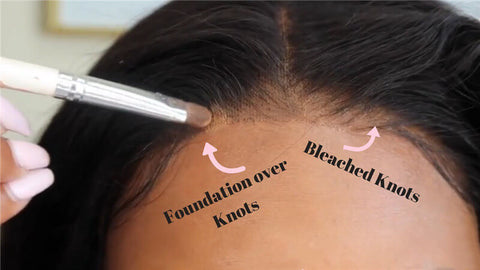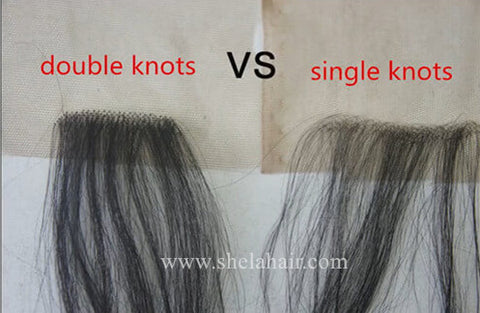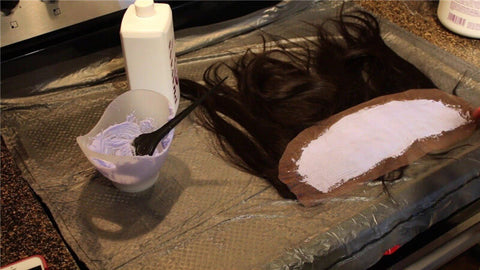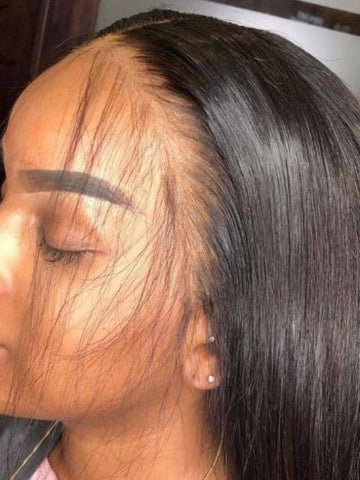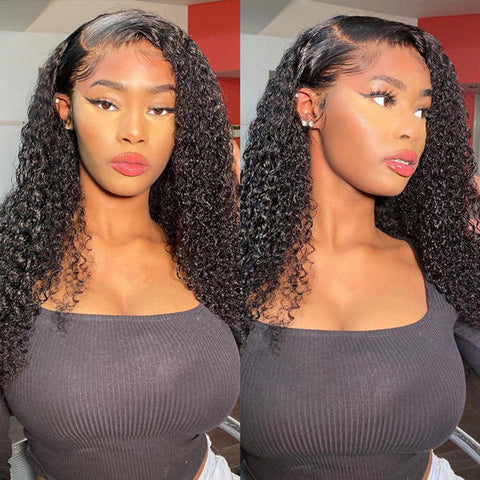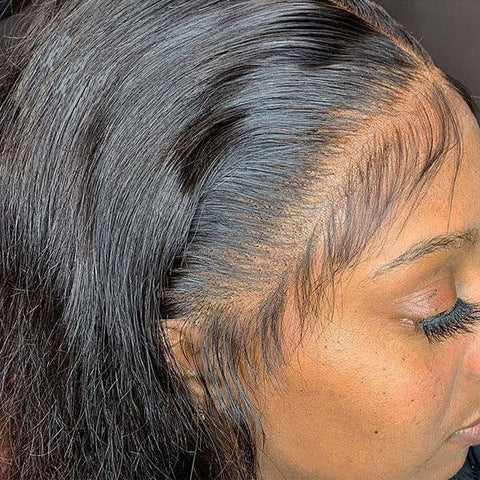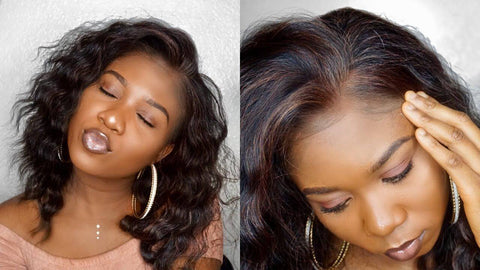Bleaching your lace closure, lace froontal wig knots is a popular method quite effective if you want to have a realistic look. When it comes to lace products like lace closures, lace frontals, and lace wigs, we've all heard of "bleaching knots," but what exactly does that mean?
When hair is knotted to a lace base, each strand is secured with a black knot. Bleaching these knots helps make the hair look as if its sprout from the scalp, giving it a more realistic look. This article talks about the proper procedure for bleaching your knots.
What are knots?
The knots are those black specks in the root zone that are the result of human hair lace implantation.
There are two types of knots: single and double. Doubles are slightly more durable than simples, but simples are more prevalent. It shows on each lace closure, lace frontal, lace closure wig, lace frontal wig, full lace wig, full 360 wig. When you purchase a lace wig on our Shelahair.com mall, you can leave msg if you need a light bleach knot.
Single knots
These knots are the most common because they are invisible to the naked eye. Each strand of hair is linked to the entire wig system with a tiny knot.
The most significant benefit of this knot type is that it is virtually undetectable, giving it a far more natural appearance. Even though the knots appear natural, it is essential to remember that they are easier to loosen with repeated use. This could lead to a significant loss of hair. That's the reason why most of black ladies prefer double knots human hair lace wigs.
Double knots
When you want to have thick and heavy hair, this form of knot is ideal. All high density wigs are double knots. Its durability is better than that of single knots due to its double knot system. Also, because double knots are more resistant, hair that comes out due to everyday use will be considerably less.
Achieving a stronger knot entails double knotting the hair. The disadvantage of double knots is that they are considerably more apparent due to their size, affecting the natural appearance of the hair when the scalp is closely examined.
Defining Bleached Knots
When it comes to closures, frontals, and lace wigs, we've all heard of "bleaching knots," but what exactly does that mean? Ordinarily, each strand of hair is secured with a black knot when it is fastened to a lace base closure or frontal. Some people aren't bothered by knots, while others can't bear them, hence the reason to bleach.
When should I bleach closure/Frontal Knots?
You should bleach the knots if you bought a lace closure by adding final touches to a sew-in wig and want it to look more natural. Bleaching or lightening these knots on your lace closure or frontal can assist make the hair appear to be sprouting from your scalp and lessen its visibility.
The hair opens its cuticle and eliminates the pigment in an irreversible chemical reaction when you bleach the knots. The knots are then lightened to a light brown tone f. Knots that are very golden brown or blonde don't need to be bleached. Bleaching the knots in jet black hair is complex.
Step by step procedure on how to bleach your closure/Frontal Knots
Things you'll need
- Mixing Bowl and brush
- Bleach
- Aluminum Foil
- Developer
- Begin by turning your wig inside out and place it on a mannequin head. If your closure/Frontal has baby hair, make sure you get them out of the way by pinning them down using clips.
- Use a bowl to mix the developer and bleach powder while you stir thoroughly until it evenly blends. In simpler terms, ensure that there are no lumps on the liquid.
- Next, gently use the brush to mix the liquid, then dab it onto your lace. While you use the brush, avoid applying too much pressure on the lace as it leads to leakage of the bleach underneath your wig. Add sufficient bleach on all the knots, and when done, cover your lace using aluminum foil.
- Let the bleach sit-in until all the knots blend perfectly with the color of your wig.
- Rinse your closure/frontal while it's facing upside down, then use a neutralizing shampoo to minimize the chemical processing. Let the shampoo sit in for about 5 to 10 minutes, then rinse it off. Finally, condition your hair to prevent it from drying out.
Factors to consider when bleaching knots on a closure/Frontal
- Avoid oversaturating your closure using bleach since this might cause your natural hair to get bleached too.
- Make sure that you use the right developer volume of developer volume (between 20 to 30ml)
- The bleach mixture should be thick and not runny to be effective.
- Always ensure that all the baby hair is combed and pinned adequately out of the way before you begin the bleaching procedure.
- Also, ensure that you have sufficient bleach quantity if you want to cover all the knots on your wig completely.
- After you apply the bleach, always let it sit in until it turns into a honey blonde hue, then wash it off.
- After the bleaching procedure is done, use a neutralizing shampoo to minimize the chemical formed.
Bleaching knots: Advantages and Disadvantages
The purpose of bleaching knots is to make them less noticeable and as natural-looking as possible, as if they are part of our scalp. In addition, bleached knots have the effect of making the hair look as if it's growing from the scalp, giving it a more natural appearance. The idea behind bleaching is that the knots that hold the hair in place are invisible.
Advantages of bleaching knots
- The main advantage of bleached knots is that they are less noticeable and appear more natural.
- Knots can be mistaken for the scalp with the naked eye because the color of the knot fades after bleaching.
- This gives the hair's origin a more realistic appearance.
- Furthermore, the wig's hair remains resistant after the knots have been bleached.
- After hair installation, the knot whitening helps us remove the root zone's black stains.
- The hair root appears lighter and less noticeable to the naked eye.
The disadvantage of bleaching knots
- One downside is that this treatment must be done with extreme caution.
- If you aim to get a more natural look, it's not good to go overboard with bleaching.
- Chemicals used in this treatment, which may cause hair damage.
- This chemical treatment can diminish the wig's lifespan if the knots are bleached excessively. It will be more fragile and easy to drop down because it become a tiny knot after bleaching knot.
- It's a process that requires patience and the right ingredients when done for the first time. This is to avoid sabotaging the desired impact.
- After bleaching, Black areas on the wig may weaken. But for this problem, it is easy to fix. You can use some black hair colorer to cover it.
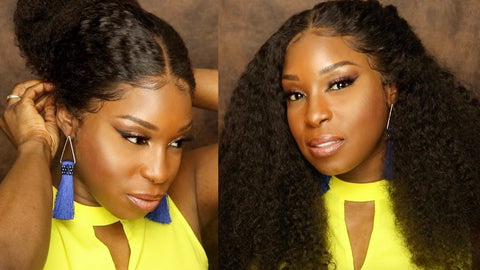
FAQs About Bleaching Knots
- How long should my knots be bleached?
You can check the lace closure every 5-7 minutes, and if you use the 30 volume developer, it may take 20-25 minutes. This may vary depending on the product! Most people use a 30 volume developer; if you use a 20 volume developer, it may take longer to process; if you use a 40 volume developer, it may process faster.
- Can bleaching knots cause them to shed?
The darker your hd lace wig, the harder it is to bleach it entirely. In fact, rather than bleaching black hair knots to make them gold, we advocate lightening them. Bleaching hair from a dark color to a very light color will result in quick and significant hair loss.
- Can I bleach my closure/Frontal knots twice?
When the wig is naturally black, it will be an exception to the norm, and we will carry out the second-knot bleaching.
But, pls remember that coloring the wig knots is next to impossible once the wig has been dyed, even on a dark color.
It's usually recommendable and feasible to do it only once if you want to preserve the wig's quality. Too much chemical is harmful to your hair and can drastically reduce its lifespan.
- Can i bleach knots when my hair is wet?
It is feasible to lighten the knots of the wig while the wig is wet, just as it is possible to lighten the hair while it is dry. However, the process will be much easier to complete if the wig is wet.

